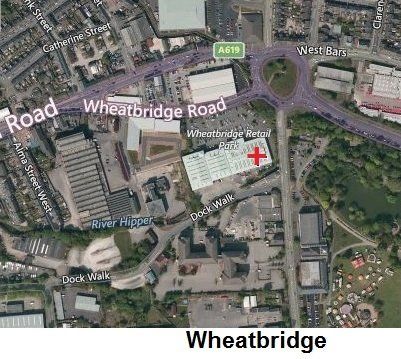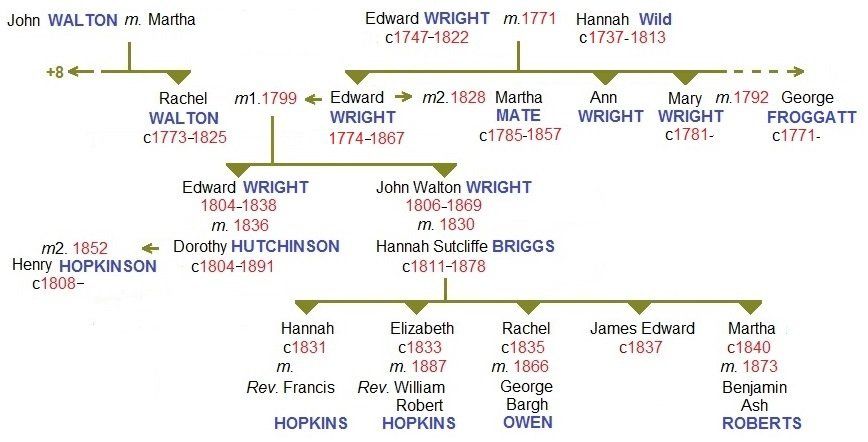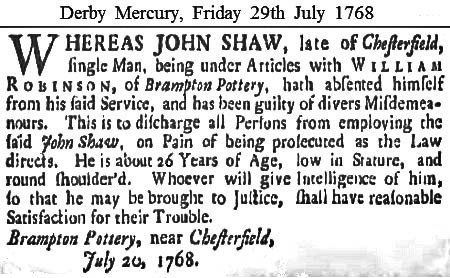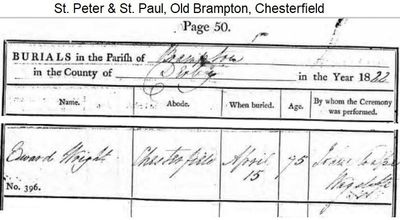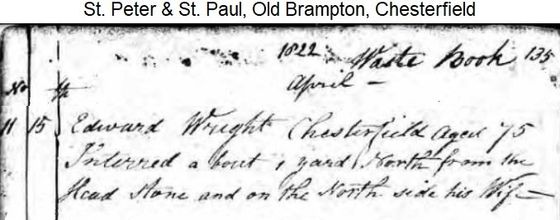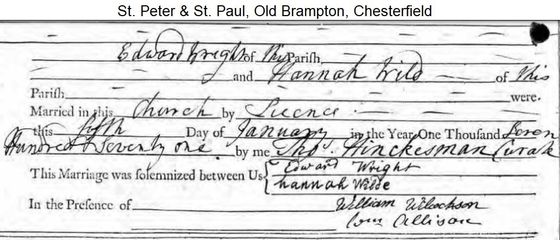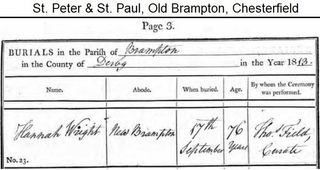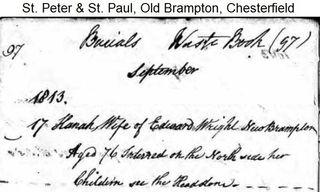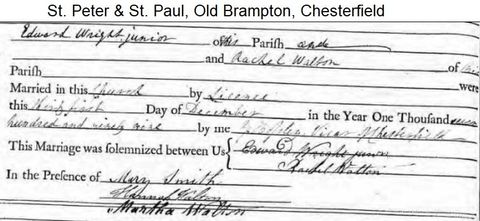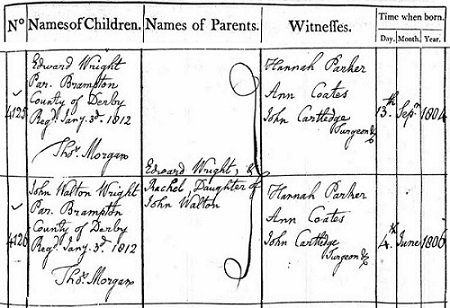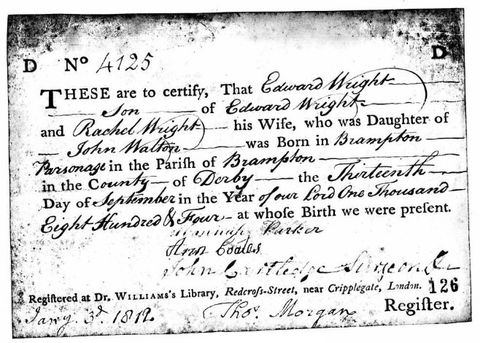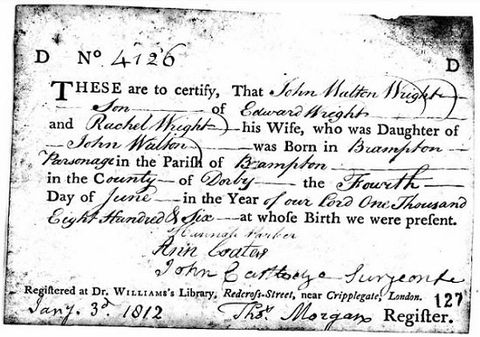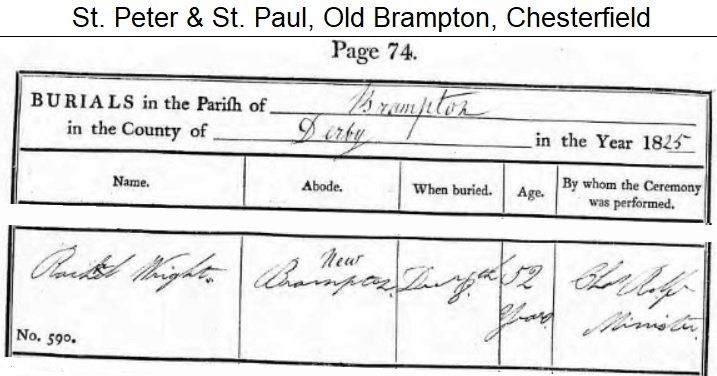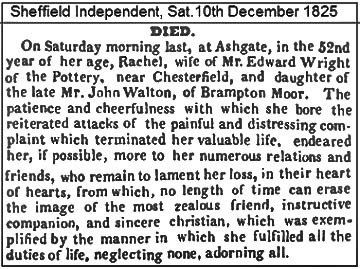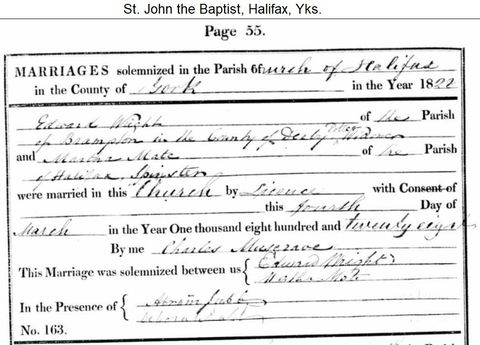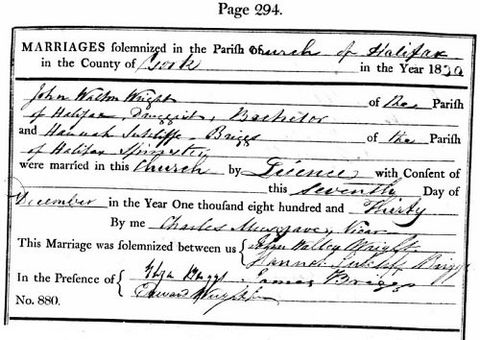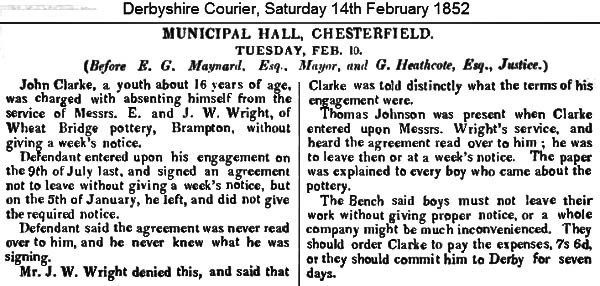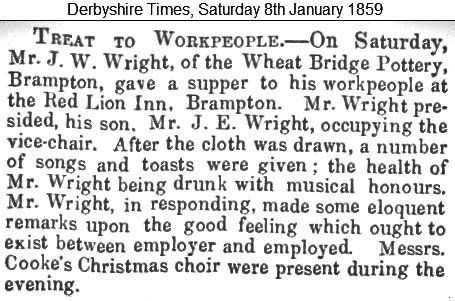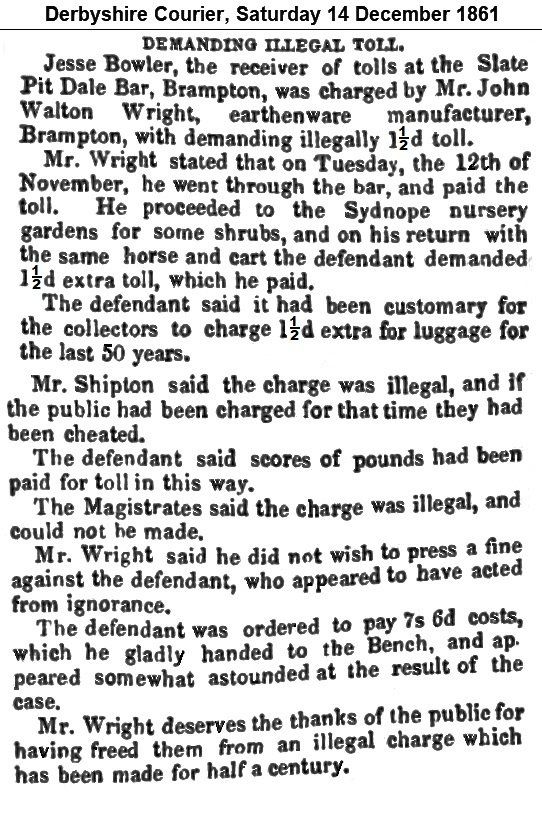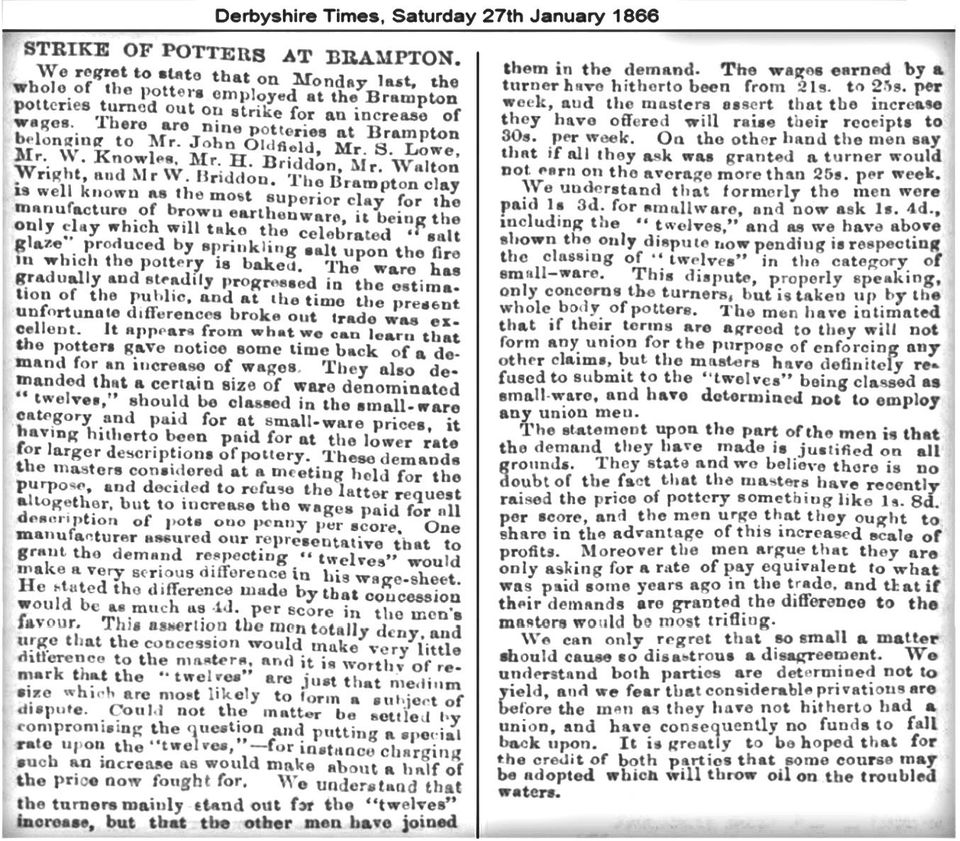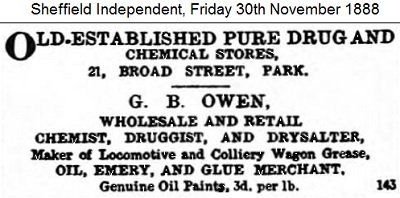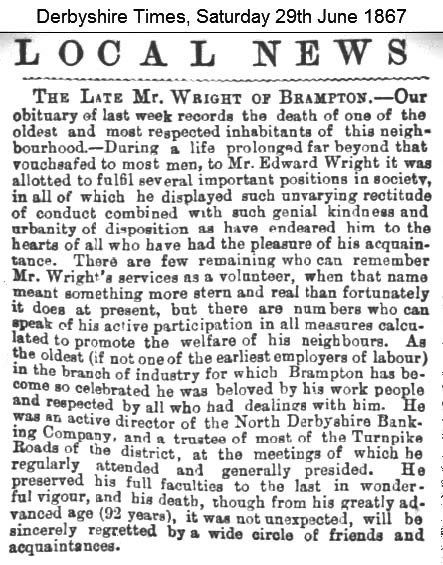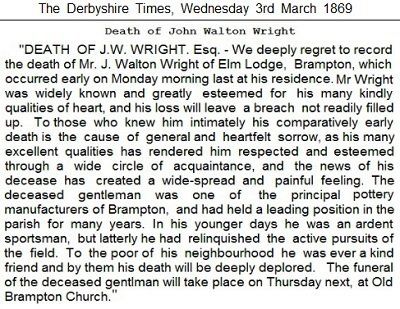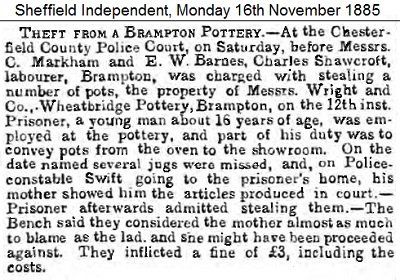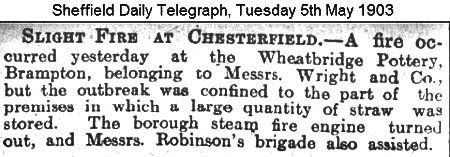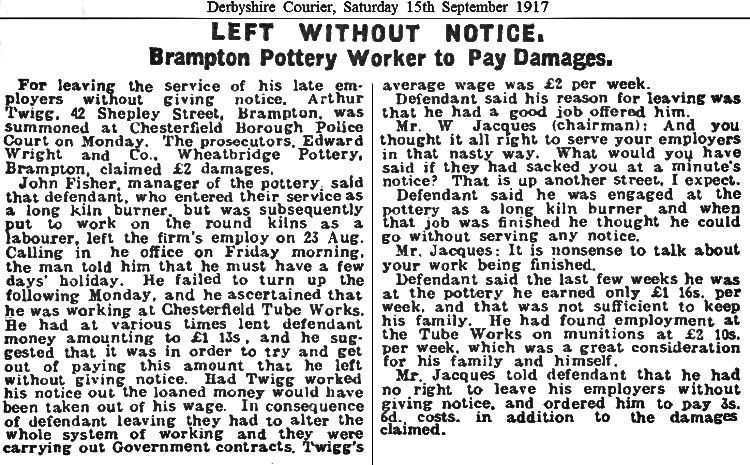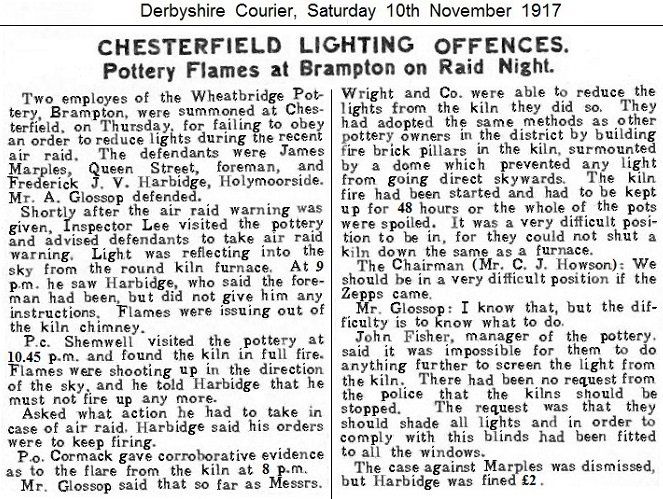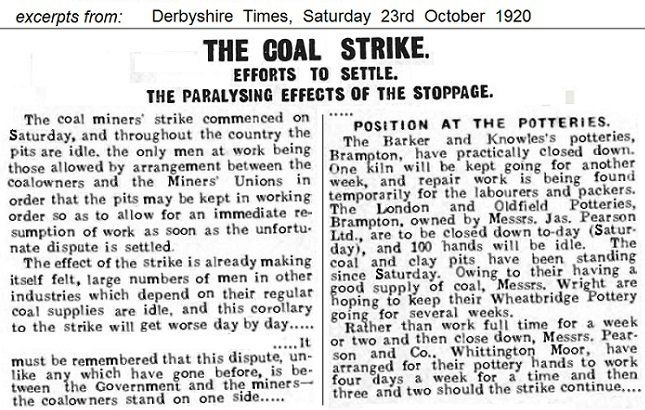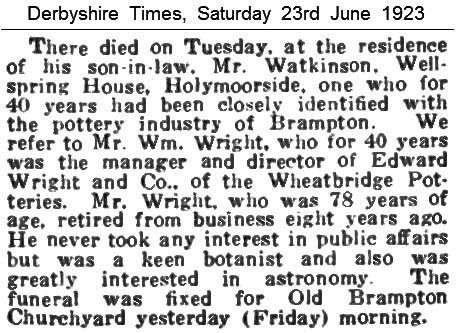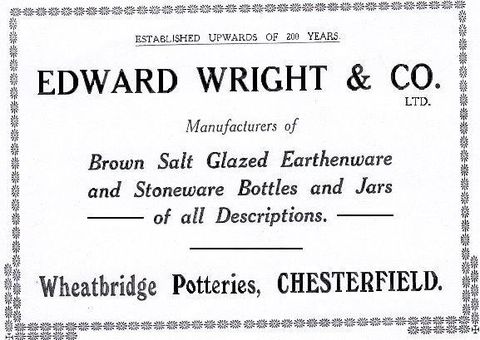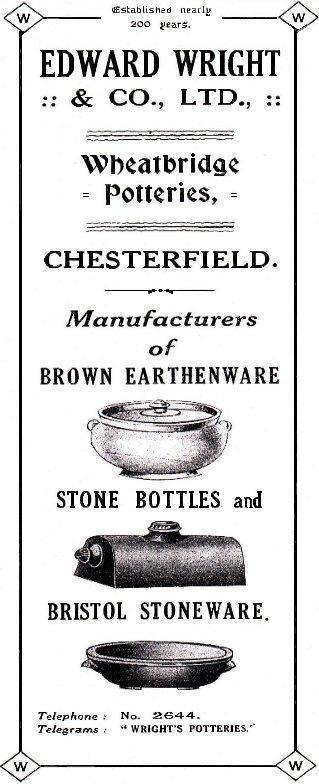Rachel Wright [nee Walton], was born c1773, & died on the 3rd December 1825. She was buried 8th December 1825 at Sts. Peter & Paul, Old Brampton, Chesterfield.
Wheatbridge Pottery, Brampton
Short Summary:
Edward Wright
[c1747-1822] ran the pottery. He married Hannah Wild in
1771 & had 1 son named Edward. When Edward senior died he left the pottery to his son Edward
[1774-1867].
The pottery passed from Edward Wright
[1774-1867] to his younger son John Walton Wright; Edward's eldest son, also named Edward, having died in
1838.
It was later sold but carried on trading as Edward Wright & Co./Co. Ltd.
To prevent confusion I've addressed the Edwards' by their dates of birth/death.
The WRIGHT Family Tree.
Edward Wright was born c1747 & lived until
10 April 1822, aged 75 years. He was buried at Sts. Peter & Paul, Old Brampton, Chesterfield on
15th April 1822.
Edward & Hannah had two daughters, that I know of, named Ann & Mary; & one son, named Edward [1774-1867]. At the time of Edward's death in
1822 Ann was unmarried & Mary was married to George Froggatt of Boythorpe Lane, crate maker; His son Edward was still married to Rachel (nee Walton).
Edward had made a Will on the
29th May 1821, which was probated on
25th April 1822.
In his Will he gives his unmarried daughter Ann £50 within one month of his death & an annuity of £40 given quarterly beginning 3 months after his death. She also has the use of household goods until she either dies or marries & then it goes to his son Edward.
His daughter Mary, wife of George Froggatt of Boythorpe Lane, a crate maker, will receive £100 within 12 months from his death. George Froggatt will receive all the tools & wood for the crate making business, so that it will help him carry on the trade for his own benefit. He also left his grandson Francis Froggatt his silver watch.
After debts paid, & bequests made, Edward's son, Edward receives everything else, ie stock in trade, books, personal estate, dwelling house, potteries & all buildings connected with it, warehouses, stables, yards & gardens, & land near Wheatbridge.
Edwards executors were his son Edward Wright, William Robinson of Chesterfield, hosier & draper, & John Walton of Chesterfield, grocer. His estate & effects were under £600.
Edward Wright [1774-1867] was Edward & Hannah's only son & he carried on the pottery business as an earthenware manufacturer of brown & stone ware & stone
bottles. He was born on the
1st September 1774 & died on the
15th June 1867.
He married his first wife, Rachel Walton, on the 31st December 1799 at St. Peter & St. Paul, Brampton.
He married his first wife, Rachel Walton, on the 31st December 1799 at St. Peter & St. Paul, Brampton.
Rachel was one of nine children born to John Walton, School Master, & Martha. Her grandfather also John Walton was a cordwainer from Halifax, Yks. who then moved to Brampton, Dbys. Her grandfather left in his will, in 1801 – with the exception of a few bequests – everything to be shared among his 12 grandchildren. It was Rachel who became executor when the 3 executors named renounced their position in favour of Rachel.
John & Hannah had five children [that I know of]; Hannah, Elizabeth, Rachel, James Edward & Martha; all of whom were born & baptised in Halifax, Yks., except for the youngest, Martha, who was born in Hasland, Dbys.
James Edward the only son was born on the 25th February 1837 on Silver Street, Halifax.
James Edward the only son was born on the 25th February 1837 on Silver Street, Halifax.
The census' of
1841 brings Edward Wright, [1774-1867], Pot Maker, living with his 2nd wife Martha at New Brampton; & his son John Walton Wright is living at Boythorpe Lane, Hasland, an earthenware manufacturer, with his wife Hannah & children Hannah, Elizabeth, Rachel, James & Martha. If John had been living in Halifax with his wife & family before his brother Edward's death it would account for all the children bar one having been born there. John would've come back to Brampton to take over Edward's place in the family business.
The pottery business was still carried on by Edward & his son John throughout the
1840's; there was however a dispute over land & hereditaments in Ashgate which was settled on
13th November 1844.
The land & hereditaments involved were on lease for 1,000 years & had been bought & transferred a few times before Edward Wright [1774-1867] decided to buy them until the end of the lease period.
At that time Edward Addy was in possession of it but owed Robert Nall for the lease. Edward Wright paid Robert Nall £517 3s. on Edward Addy's behalf; he also paid Edward Addy £82 17s; & John Walton paid Robert Nall 5s.
At the request of Edward Addy & Edward Wright the property was transferred to John Walton.
John Walton died intestate, which left a bit of a mess, so it was taken to arbitration & finally decided that Edward Wright was legally entitled to the land etc for the term of what was left of the 1,000 years.
Under dispute was the house & yard belonging to Francis Wildgoose, & land etc adjoining or near to it commonly known as Little Croft or Croft; The Orchard, The Great Croft or Gorsey Close which was in William Higginbottam's possession. The total area was about 4 acres & one rood; & also included was the seats & pews in the Parish Church of Brampton.
1851 brings Edward & his second wife Martha living at Wheatbridge & being a Potter & Collier employing 40 men. His son John, a Pottery manufacturer, of a firm of 2, employing 35 hands, was living on Brampton Moor with his wife Hannah & children Hannah, Elizabeth, Rachel, James & Martha.
Derby Mercury Wednesday 10th December 1851 A Body found in the Brick Yard.
“DEATH FROM EXPOSURE TO THE COLD.- Shortly after nine o'clock on Sunday morning week, Henry D'Arcy, an Irish hawker, living in Beetwell Street, Chesterfield, was found dead in the brick-yard of Messrs. Wright and Son, Wheatbridge Pottery, Brampton. He had been to two public houses, the Griffin, and the Rodney, on Saturday night, and had stayed late, leaving in a state of intoxication. A friend accompanied him a part of the way home, bidding him goodbye near the Compasses[sic] Inn. Nothing further was seen of him until Sunday morning, and it appears probably that in going up West-bars, the desire for more drink pressed upon him so strongly that he determined to turn back to the public house, but becoming, from the darkness of the night and his state of inebriation, confused, he missed the turn to the Rodney, and went up Boythorpe Lane; turning to the right by some houses, about 100 yards from the Brampton road, he had, it is conjecturred[sic], crossed the river Hipper, climbed up the bank, and laid or fallen down about 15 yards from the stream. The night was very frosty, and life was quite extinct when he was discovered. The body was taken, by direction of a constable to the Griffin Inn, where an inquest was held the following morning. The jury were all of opinion that death had resulted from exposure to the cold, and returned a verdict accordingly.”
Arson or accident? 💥
Sheffield & Rotherham Independent, May 14th 1859
SUPPOSED INCENDIARY FIRE.- On Wednesday morning, about ten o'clock, two straw stacks, upon the premises of Mr. J. W. Wright, Brampton Pottery, were discovered to be on fire. The stacks are supposed to have been fired by some incendiary.
Derbyshire Times, 14th May 1859
J. W. Wright begs to tender his best thanks to those parties who so kindly assisted in extinguishing the Fire at Wheatbridge Pottery, on the 11th instant.
1861 arrives & John & his wife Hannah & children Rachel, James & Martha move to Ashgate Rd. John is now running the firm employing 15 men & 20 boys; Edward has now retired & has his granddaughter Hannah Wright living with him at Wheatbridge.
Derbyshire Courier, Saturday 15th June 1861
To be Let or Sold,
A GENTEEL RESIDENCE, situate at Brampton, containing Dining and Drawing-rooms, four principal Bed-rooms, Kitchen, and Scullery, well supplied with water; a large walled Garden well stocked with fruit trees, late in the occupation of Mr. Walton Wright.
For particulars of Rent, &c. apply to Mr. S. DENHAM, Chesterfield.
Derbyshire Times Saturday 31st January 1863 Summary
PUBLIC MEETING AT BRAMPTON.- THE GAS QUESTION 🔥
An influential public meeting of the inhabitants of Lower Brampton was held in the School Room, on Friday Evening at six o'clock. There was a large attendance, & the Rev. W. Peach was called to the chair.
Rev. Peach
explained that he had reluctantly opposed the lighting in the past because a large number of rate payers would have to pay for it but would not receive any benefit. The boundary marked out at a previous meeting was different to the one marked out primarily & the one marked out now; so he now advocated it. He was aware that some little hardship & injustice upon some of the rated inhabitants would be done but he thought the scheme now proposed would entail as little of that as possible. The only property not benefited by it was the Bridge Inn, but among other owners & occupiers there was generally no argument. He then read out the area in the district to be lighted:
"The lighting will commence on a boundary on the south by the river Hipper; on the west by an occupation road leading from the bleach works of Messrs. Hewitt & Co., across the Chesterfield road, by the back near Mr. Irving's, to the footpath leading from Ashgate; on the north & east by the Ashgate road leading from Linacre brook."
Mr. M. Knowles
moved & Mr. Walton Wright seconded a resolution that the provisions for lighting should be adopted & carried out. The resolution was carried unanimously.
The Chairman
said the next proposal to be adopted was to determine how many Inspectors might be nominated to carry out the act, not less than 3 no more than 12.
Mr. T. Shipton
proposed that 6 Inspectors be appointed. Mr. J. Oldfield seconded the motion. Mr. T. Shipton then moved the following persons be nominated:- Mr. Samuel Lowe, Mr. Henry Briddon, Mr. John Bradbury Robinson, Mr. Henry Kent, Mr. Mathew Knowles & Mr. Edley Taylor. Other candidates could be proposed with the restrictions being that they had to be rated to the extent of £15 per year, & resident within the district to be lighted. After a discussion the above gentlemen were elected unanimously.
The Chairman
said the question was the sum of money to be raised to carry out the act; & if it wasn't used straight away it must be used within 12 months.
Mr. T. Shipton
said it would take six weeks to erect the lamps.
It was stated that the gas company would not be entitled to rent from that time but when the lamps were lighted.
Mr. Machin, the manager of the works said the Company would charge the same for each lamp at Brampton as it did Chesterfield, ie 50s per year.
Mr. W. Robinson
moved a resolution that the money the Inspectors should have to call for in one year commencing that date, to carry out the act shall not exceed £75.
Mr. Shipton
said the cost of the lighting would be 7d in the pound. The Chairman said they would be able to carry on with 5d rate when the new assessment was done.
Mr. S. Gregory
seconded the motion for the call of £75 which was carried unanimously.
Mr. G. Hewitt
asked if £75 was enough to light the district as it should be, & the Chairman replied the Inspectors will do it as well as they can.
Mr. Shipton, replying to a question, said it was intended to light about thirty lamps.
Mr. W. Robinson
asked if the Gas Company would charge for a year if they used the lamps less than a year: Mr. Machin replied no.
Mr. W. Robinson
then proposed that the Inspectors be asked to commence the lighting immediately. Mr. G. Hewitt seconded the motion.
Mr. Irving
proposed a vote of thanks to the Chairman for presiding, & congratulated the meeting that the time had arrived for lighting the streets of Brampton with gas. (Cheers)
Edward sells his house & moves to Storrs Lane.
Derbyshire Courier, Saturday 17th June 1865
TO LET, with Immediate Possession, the HOUSE at Wheatbridge Pottery, late in the occupation of Mr. Edward Wright.
Apply on the Premises.
The Potters' Strike for more pay:
George was born c1835 in Sheffield to Sarah Owen. I
don't know who the father was as he must've died early in
George's life, but Sarah brought him & his siblings up
while she worked as a druggist, & she lived over 76 yrs.
George & Rachel lived in Sheffield until their deaths, in
1904 & 1913 respectively. As Rachel's husband he be-
came a director/owner of the pottery for a while. Four out
of their five children were still alive at the time of the
1911
census: George, Rachel, Ellen & Margaret.
Edward was also a partner in a bank & had been one of the first directors when it opened on
1st January 1834. He was still a partner in
1867 along with other pottery manufacturers.
Derby Mercury 20th February 1867
The Chesterfield and North Derbyshire Banking Company;
Persons of whom the Company or Partnership consists:- Name; Residence & Occupation.
Sarah Bainbridge Chesterfield Spinster
Henry Briddon snr., executors of Brampton Potter
Luke Knowles, executors of Brampton Potter
Aaron Madin Newbold Gent
Mary Madin Brampton Spinster
Edward Wright Brampton Gent
The death of Edward Wright.
On the
15th June 1867 Edward Wright, of Storrs Lane, Gent., at the age of 92 years, died. He was at the home of his son, John Walton Wright, of Elm Cottage, Brampton. He was buried
19th June 1867 at St. Peter & Paul, Old Brampton, Chesterfield
Edward left a Will with his son, John Walton Wright, being
the sole executor.
He left his daughter in law, Hannah 115 Shares of £5 each
in the Nottinghamshire & Derbyshire Fire & Life Insurance
Company & 2 Shares of £25 each in the Kingston on Hull
Gas Light Company for her own use & benefit.
He also left an annuity of £50, duty free, to his former daughter in law Dorothy Hopkinson, wife of Henry, to be paid half yearly, & to commence immediately after Edward's decease.
The annuity fulfills an agreement in writing, dated the
18th
October 1838, between Edward senior & his son Edward,
Dorothy's first husband.
The rest of his personal & real estate was left to his son John.
Witnessed by William Drabble & Thomas Wardle.
Effects under £450. Proved the
23rd July 1867.
Unfortunately Edward's son died 2 years later.
On the
1st of March 1869 John Walton Wright, of Elm Cottage,Brampton, died aged 63yrs. He was buried
4th March 1869 at Sts. Peter & Paul, Old Brampton, Chesterfield.
In his Will, dated
22nd February 1869, he left everything to his wife Hannah Sutcliffe & John Walton, stationer of Chesterfield. Hannah was to
“enjoy & posses the income thereof during her life and at her decease” to sell the said Estates and to divide the clear proceeds between and amongst my daughters Hannah, Elizabeth, Rachel and
Martha. He doesn't mention his son James Edward for some reason I'm not aware of. I don't know whether James had died.
The will was probated
7th May 1869; effects under £1,500.
Derbyshire Times Saturday 8th May 1869 Selling up - or trying to.
FREEHOLD PROPERTIES IN BRAMPTON & WALTON NEAR CHESTERFIELD, DERBYSHIRE.
The Residence known as ELM COTTAGE, with the Gardens, Orchard, and Croft, in Brampton, and a close of land in Walton, (being part of the estate of John Walton Wright Esq.,) will be OFFERED for SALE by AUCTION, by Messrs. DOBBS and SON, at Mr. WILKINSON'S, the Angel Inn, Chesterfield, in the County of Derby, at Four o'Clock in the Afternoon of WEDNESDAY, the 12th day of MAY, 1869, subject to conditions to be then produced:-
LOT 1
ELM COTTAGE, consisting of all that Messuage or Villa Residence, situate at Brampton, in the County of Derby, with the Pleasure and Kitchen Gardens, Croft, Orchard, Coach-house, Stable, and convenient Out-offices, late in the occupation of Mr. Wright and now in hand.
The above Residence and Premises are in every way fitted up as a convenient and pleasant abode, near to a good Road and within an easy distance of Chesterfield. The Shrubberies, Gardens and Orchard, are full of choice and thriving Shrubs, Evergreens, and Fruit Trees, and the site contains 1a. 2r. 6p. More or less.
LOT 2
All the CLOSE of rich GRASS LAND situate in the Township of Walton in the Parish of Chesterfield, and called the Lower part of Quicksets, containing by survey 4a. 0r. 33p. More or less, in the occupation of Mrs. Wright.
LOT 3
TWENTY SHARES in the Chesterfield and North Derbyshire Banking Company, in Lots of £5 each.
Mr. John Walton, Stationer, will show the Properties, and further particulars may be had, and a Plan seen at Mr. Rollinson's Surveyor and Architect, Sheffield Road, and at the Office of
Mr. CUTTS,
Solicitor, Chesterfield.
Hannah, the first daughter of John W. & Hannah Wright, had married Rev. Francis Hopkins, Rector of Athboy, Ireland.
Francis had been born there on
14 July 1827, & died there c1880. Hannah & Francis had had 3 children: Their son Francis was born in
1868 in Geelong, Victoria, Australia; & son George was born c1871 in Chesterfield, Derbyshire. Their 3rd child, a daughter, Kathleen Margaret, was born on
12th February 1873 in Athboy, County Meath, Ireland. After the Rev. Francis Hopkins died c1880, Hannah & her children went to Canada to live.
Back at the Pottery crime was afoot!
Sheffield Independent, Saturday 15th October 1870
CHESTERFIELD
FRIDAY.- Before E. G. Maynard and B. Lucas, Esqrs.
EXTENSIVE ROBBERY OF CORN AT BRAMPTON.- Samuel Biggin, Higgler, Brampton, was charged with stealing on the 12th inst., six stones of bean meal, the property of Mrs Hannah Sutclifffe Wright, earthenware manufacturer, Brampton.
About six stones of bean meal and three stones of bran were stolen from the chamber over the stables in which prosecutrix's horses are kept. On the floor Police-sergeant Watson picked up a piece of matchbox produced. It had been burnt at one end. A great quantity of meal was strewn on the floor some distance from the stable, and Watson noticed footprints of light boots without nails.
In consequence of some suspicion he had he went with Sergeant Rowse to prisoner's house at about 10 o'clock in the morning, and found him in bed. Watson told him they had come to look at some horse corn. He appeared drunk, and not to understand what was said, and asked if witness had brought him anything. The police examined prisoner's stable, which ia about 100 yards from his house. In a chest in a chamber over the stable they found about six stones of bean meal and bran mixed, and in a tub they found two or three stones of a similar mixture. They afterwards saw prisoner in the yard. Watson asked him where he had got the bean meal from, and he said he should not tell him – he was not obliged to tell where he got his corn from. In answer to the question when repeated he said he bought some from Mr. Craven, sometimes from Mr. Benj. Burton, and occasionally from Sheffield and Mansfield. Watson apprehended him, and at the lock-up searched him, and found a piece of match box corresponding with the piece found on the corn chamber floor.
At half-past one on the morning of the robbery he saw prisoner at a public house a few hundred yards from prosecutrix's works..... Mrs. Craven said she sold prisoner a stone of corn a day, and he only had that quantity on the day of the robbery.
Committed for trial at the ensuing Derbyshire Quarter Sessions.
On the
8th October 1873, at St. Thomas', Brampton, Chesterfield, Martha Wright, John & Hannah's youngest daughter married Benjamin Ash Roberts.
Benjamin was born in Bawtry, Yks. to Benjamin & Jane Roberts. He had changed his profession a few times from bank clerk to merchant to finally settling on accountancy. After Martha & Benjamin were married in
1873 they lived in Sheffield & Chesterfield but then moved by
1891 to Southport where they died, Benjamin in
1917 & Martha
1916. They had 2 sons, Francis Hugh & George Sidney Roberts.
Sheffield Daily Telegraph, Friday 10th October 1873
MARRIAGES.
ROBERTS - WRIGHT.- Oct. 8, at St. Thomas' Church, Brampton, by the Rev. Francis Hopkins, rector of Athboy, Ireland, Brother-in-law to the bride, assisted by the Rev. J.M. Mello, rector, Benjamin Ash Roberts, Sheffield, to Martha, youngest daughter of the late John Walton Wright, Brampton, Chesterfield. No cards.
The pottery was still carried on after Hannah's death under the name of Edward Wright under joint ownership: In John Walton Wright's will his 4 daughters would have equal shares in the pottery.
When your word & reputation meant everything then slander was taken very seriously.
Derby Daily Telegraph & Reporter February 10th 1880
Derbyshire Assizes: Crown Court
ACTION FOR SLANDER: A SINGULAR CASE
JOHNSON v. BRIDDON AND GIBBONS.- Mr. Lawrence Q.C., & Mr. Dugdale appeared for the plaintiff; Mr. Mellor, Q.C. & Mr. Daniel for the defendant Briddon, & Mr. Busard Q.C., for Gibbons.
The plaintiff is the manager of a pottery near Chesterfield, & Briddon is a manufacturer of pottery in the same neighbourhood, & Gibbons was his manager.
The slander was alleged to be uttered by Briddon & repeated by Gibbons, & was to the effect that Johnson had defrauded his employers. The plaintiff said he was the manager of the Wheatbridge Pottery, Brampton, owned by the executors of Mr Wright. He had been in that employ for 40yrs. Briddon was an earthenware manufacturer at Brampton.
Some time ago Gibbons made a statement to plaintiff as to what his employer, Briddon, had told him on the 2nd May. Gibbons came to the pottery on business, & in presence of plaintiff & a clerk, named Wright, he said his employer
[Briddon] said he
[Johnson] had defrauded his employers of all he had got. He subsequently saw Gibbons again & asked him how it was his employer should have said such a thing about him. Gibbons then said he & his employer had had some words some weeks previous, & he told his employer he should fetch Tom Johnson to manage for him & he should show him what managing was. He
[Briddon] then said, “he would not have such a thief as Johnson on his premises”.
When Gibbons was called to testify he denied telling the plaintiff anything about him. He had never heard Briddon say anything disrespectful of the plaintiff, or say he had defrauded his employers. He did not say that in the presence of the clerk. He had heard the plaintiff's evidence & it was all untrue. Their conversation was all respecting about witness purchasing the pottery & Johnson told him not to let Briddon 'salve' him over. They did not have any talk about anything Briddon had said. Briddon only spoken of Johnson to do with business.
The learned Judge said there was no case against Gibbons, because what he stated was at the solicitation of the plaintiff. There was also insufficient evidence against Briddon. Mr. Lawrence said the only material evidence was that of Gibbons & he denied everything. The judge said the plaintiff was non-suited.
Derbyshire Times 28th May 1887
THE THEFT OF EARTHENWARE AT BRAMPTON.
HEAVY PENALTY.
At the Chesterfield County Police Court, on Saturday, before C. Markham, J.B. Barrow, E.W. Barnes & W. Parker Esqrs.
William Townsend, packer, & George Richardson, hawker, Sheffield appeared, the former was charged with stealing 21 doz. of earthenware, value 21s., at Brampton, on the 10th May, the property of Messrs. Wright & Company, potters, Brampton; & the latter with receiving the same knowing it to be stolen.
Mr. J. Middleton (Messrs. Jones & Middleton, solicitors, Chesterfield), prosecuted, Mr. Glossop, solicitor, Chesterfield, defended Townsend, & Richardson was defended by Mr. Muir Wilson, solicitor, Sheffield.
Mr. Townsend had been employed as a packer for some years at the Wheatbridge pottery. Mr. Richardson owned a pot-wagon & travelled the Country with pots & stood at the different markets.
On the 10th May Richardson called at Wheatbridge Potteries - as had been his habit for several years - & asked for a certain quality of pots ie thirds. The manager told him to have 30 or 40 doz. He asked, “shall I go to William”
[Townsend], & was told yes, so he went to the packing house. Townsend un-packed pots, gave them to a lad to give to Richardson, who packed them on his cart. When the cart was loaded Richardson went to the office to pay the manager Mr. James Skelton. Mr. Skelton, who had been warned via an anonymous letter that something underhand may be going on, asked Richardson how many pots he had & was told 35 doz.. Richardson paid for 35 doz. Mr. Skelton then went to the cart where the pots were covered over with straw & saw the pots in the packing house were partly covered over also. He told them to un-pack the cart, which they did, & the pots were counted. He found there were 56 doz. & amongst them were some best pots, not thirds, which meant Richardson had £1 7s 6d worth of earthenware he had not paid for. Townsend had been a packer for years & he could have no excuse that he had made a mistake in counting; Richardson also bought & sold by the dozen so there was no excuse for him either.
James Skelton, manager of the Wheatbridge pottery, Brampton, belonging to Mr. Owen and others but trading under the name of Messrs Wright and Co., testified that Richardson always took 'thirds', & after being asked for some by Richardson, told him he could have 30-40 dozen. Richardson took his wagon inside the packing house to Townsend & he could not see the packing of the wagon. It was 20 minutes later that Richardson came to the office to pay him for the 35 dozen - 35s - the usual price. Mr Skelton then went over to Townsend & said, “This man Richardson has had 35 dozen, William.”
Townsend said, “Yes, that's quite right”. Mr Skelton then had the cart unloaded & counted the pots, & found there was £1 7s 6d more pots than were paid for. He asked Townsend, “How do you account for this William”, & was told it was a mistake. He then asked Richardson if he knew anything about it & was told, “No”. Richardson also said he had not noticed the differences in quality or quantity. When asked what he had given Townsend he said, “I've given him nothing, but I've paid for a quart of beer”.
As Mr Skelton had received an anonymous letter to what was going to happen he had invited Police Constable Oliver over to the pottery beforehand; & the Constable then charged Townsend with stealing 21 dozen of earthenware, value 12s., & Richardson with receiving the same, knowing them to be stolen.
Both the defendants pleaded not guilty. The bench retired from the Court for a few minutes & when they returned Mr Markham
[the chairman] said the Bench were unanimously of opinion that it was impossible for the defendants to have made such a great mistake in the number of articles, or at all events to such an extent as they had done. They had decided to impose a fine of £5 including costs, or one month's hard labour on Townsend; & a fine of £2 including costs or 14 days hard labour on Richardson.
Good neighbours.....
Derbyshire Times Saturday 5th July 1890 Summary
DRINK AND DEATH AT BRAMPTON
A SHOCKING CONDITION OF THINGS
“On Wednesday Afternoon an inquest was held at the Griffin Inn, Brampton, before Dr. Feilden, deputy coroner, on the body of Thomas Troupe, aged 57, a slater, whose death occurred under shockingly sad circumstances. The deceased's family relations have been of a very unfortunate and uncomfortable character-drink apparently being the root of all evil.”
The first witness was the widow, Jane Troupe, living at Wide Yard, Brampton, who said her husband was a slater by trade,
“when he did any work”. She last saw the deceased on Sunday when he went home for his spectacles. He had only been home occasionally of late - they did not have a house of their own.
The Coroner said it appeared deceased would sleep anywhere rather than home.......
Henry Eyre, of Alma St., Brampton, pottery labourer, who was employed at Wright's pottery, said he found the body about 5 o'clock on Tuesday afternoon at the open end of one of the kilns. The body was on the floor & there was a pool of blood - deceased's head being badly injured at the back. He was quite dead but witness had no idea how long he had been there. A little lad came to him & said he had looked through the keyhole to the kiln &,
“there was a man asleep inside”. He went to see for himself & found the body.
Eyre said there were men at work until 9 o'clock Saturday night & the place was shut up until the body was found Tuesday......
Thomas Lowe who said he was a collier & lived in the Rodney Yard Brampton, said he was with Troupe on Sunday. They came out of the Jubilee field together about 9.15 pm, then went to the Butcher's Arms until closing time. Troupe then went home to fetch some spectacles & they then went to Wright's pottery - Troupe was very 'fresh' & said,
“I will not go home anymore”. They went up a ladder to the top of the kiln & Lowe lay at the bottom end near the ladder & Troupe lay at the other. They arranged to get up at 4 o'clock & if one got up earlier they would meet at Jubilee field. Lowe got up around 4 o'clock but did not see Troupe so he went to Jubilee field to find him. Although he searched for Troupe he did not find him that day.
By the Coroner: They had altogether 3 quarts of beer & porter mixed at the Militia canteen in the Jubilee field - 3 quarts for 9d. They then went to the Butcher's Arms & had 3 pints - Troupe paid for 2 pints of 'two penny' - he borrowed a penny & the landlord gave Lowe 1 pint. They were in the Jubilee field from 6pm till 9pm then the Butcher's Arms from about 9.15pm till closing time.
Sergeant Moss said he believed the deceased was in the kiln from Sunday night. A cap was found, which had been identified by the deceased's widow as belonging to the deceased, on the top of the kiln where Lowe had testified the deceased had slept. From that place to the ground was 18 feet. The sergeant said both the deceased & Lowe had previously worked at the pottery so knew it well, & on Tuesday a woman had been apprehended for sleeping at the same pottery - she had been sentenced to 'seven days' for sleeping out........P.C. Bird spoke about examining the body & said there were no marks on it except the big wound at the back of the head.
A Verdict of
“Accidental Death”
was returned.
Sheffield Daily Telegraph, Tuesday 28th November 1893
NEW COMPANIES
“Edward Wright and Co. (Limited),-Capital £10,000 in £10 shares; to acquire and carry on the business of potters and earthenware manufacturers, carried on at the Wheatbridge Pottery, Chesterfield, under the style of Edward Wright and Co.”
Derbyshire Times Saturday 2nd December 1893
Public Notice
The Subscription List will be opened on Friday the 1st December, 1893, and will be closed on Saturday the 9th December, 1893
EDWARD WRIGHT & COMPANY LIMITED
(Incorporated under the Companies Acts to 1893, whereby the liability of a Shareholder is limited to the amount of his shares)
CAPITAL
£10,000 divided into 1,000 Shares of £10 each.
Payable £1 on application, £3 on Allotment, £1 on the 24th June 1894, and the balance when called for.
DIRECTORS -
Mr. WILLIAM WRIGHT, Myrtle Villa, Fairfield Road, Chesterfield. Pottery Manager (Managing Director and Chairman).
Mr. DAVID SKELTON, 21 Spencer Street, Chesterfield. Pottery Manager (Managing Director)
Mr. ISAAC MARGERESON, Barlow, near Chesterfield. Builder.
WILLIAM BRINING, Esq., Abercrombie Street, Chesterfield. Chartered Accountant.
HERBERT BEARD, Esq., 380 Ecclesall Road, Sheffield. Estate Agent
BANKERS -
CROMPTON & EVANS' UNION BANK LIMITED, Chesterfield.
SOLICITOR -
WILLIAM GLOSSOP, Esq., 46 Holywell Street , Chesterfield, and Hoole's Chambers, 47 Bank Street, Sheffield.
AUDITORS -
Messrs. SEPTIMUS SHORT & Co., 19 Saltergate, Chesterfield, and Montgomery Chambers, Hartshead, Sheffield.
SECRETARY (pro tem.)
Mr. W. H. CLAYTON
REGISTERED OFFICE -
WHEATBRIDGE POTTERY CHESTERFIELD.
Prospectus and Forms of Application for Shares can be obtained at the offices of the Company, and of the Bankers, Solicitors, and Auditors.
Chesterfield, 30th November, 1893
Derbyshire Times 13th June 1896
“A Pottery Girl's Quarrel”
George Lowe, of Barker lane, was summoned for having assaulted Lucy Ulyett, on June 8th. Mr J Middleton (Messrs. Jones and Middleton, Chesterfield) prosecuted. Prosecutrix said she worked at Wheatbridge Pottery and so did the defendant. She was at work at her bench when the defendant came in on business. He asked her what she had been saying about him, and she said, “What I have said I can say to your face.”
Defendant then struck her on the side of her face with the back of his hand. She was unable to work for an hour:
By defendant: When he called her names, she called him names back. She did not disown it. Sarah Dolphin, working with the complainant, corroborated.
By the Bench: Complainant used bad language. She called him a ____ liar.
Defendant: I think when a young woman used language like that it was time to give over. It is her regular discourse. Witness admitted that defendant pushed the girl on one side, telling her he would not talk to her any longer.
Dr. Geo. Booth said there was no doubt defendant had considerable provocation, but he had no right to take the law into his own hands. He would be fined 1s and 11s and 6d costs.
Derbyshire Times Saturday 17th June 1899 Incident at Wright's Pottery, Brampton
According to the story which was related to the Chesterfield Borough Magistrates on Thursday, some nice language was heard at Wright's pottery at Brampton, on the 7th June.
Mary Buxton told the Magistrates that she and Walter Eyre worked at this Pottery, and on the date named the latter threatened her with the words, “I'll black your_____ eyes,”
and she was frightened that unless he was bound over he would do her some harm.
Geo. Deeley and Jemima French bore out this version of the affair, whilst defendant stated that it was complainant who used the bad language.
Elizabeth Cooper said defendant did not use any bad language but threatened to knock complainant's teeth down her throat.
Defendant was bound over in the sum of £5 to keep the peace and pay the costs.
The Pottery had both long & round kilns as recorded here:
Derbyshire Times Saturday 29th July 1899
WANTED-GOOD BURNERS for long & rounds kilns – Apply Mr. D. Skelton, Wheatbridge Pottery, Chesterfield.
Employees were still leaving without giving notice & still being taken to court.
Problems with running a pottery in wartime.
Trouble between the coal miners & government.
The Pottery was still working in 1932 & advertising for employees:
Derby Daily, Telegraph Monday 27th June 1932
COMMERCIAL Manager, with experience of Brownware and Stoneware pottery required.- Full particulars of age, experience, salary to Edward Wright & Co., Ltd., Wheatbridge Potteries, Chesterfield.
By 1936 the pottery had closed.
Derbyshire Times 4th December 1936 Sale of Wheatbridge Pottery
WHEATBRIDGE POTTERY
Sold For £3,100 To Chesterfield Builder
The Wheatbridge Pottery, Chesterfield was sold at the Hotel Portland, Chesterfield, on Tuesday for £3,100, to Mr C.E. Gaunt, builder, Chesterfield. The property has frontages to Wheatbridge Road and Boythorpe Road, and includes 2 cottages, 16 and 18 Wheatbridge Road. The whole site contains an area of 8,036 square yards.
In answer to questions, the auctioneer, Mr Ernest S. Mitchell, said that the pottery was intact and able to be carried on as such. He added everybody had heard of the endeavour's of the Corporation to encourage new industries in the town. He did not expect that the site and buildings would be carried on as a pottery, in fact, it might well go back to the silk hat industry which flourished in Chesterfield at one time.
Dr J. A. Goodfellow commenced bidding at £1,000 and £3,000 was soon reached. Here bidding ceased for some time and then £3,050 was bid. After another long pause the lot was knocked down to Mr. Gaunt for £3,100.
The property was formerly owned by Messrs. Edward Wright and Son who for some time manufactured pots and brown ware. It was sold on the instruction of Mr. R.L. Marsden F.C.A. Receiver for the D_______ Holder.
Just a bit of information about the managers / directors involved with the pottery that I've gleaned, mostly, from the census'.
Thomas Johnson
was an early manager who worked for the pottery for over 40 years. He was born to a Quaker couple, Thomas & Hannah, on the
30th October 1821. Thomas senior was a watchmaker. Thomas junior married Ann Gee, who was 11 years his senior, in
1841 district of Chesterfield. They had no children but Ann had had a son named Thomas Gee: I don't know who the father was or if she'd been married before. He lived at Brampton except for the
1871 census where he lived on Cobden Rd., Chesterfield.
Thomas worked for Edward & John Walton Wright as a warehouse man [1851 &
1861 census]. By
1871 he was the manager of the pottery & had David Skelton
– who was to become a manager & managing director of the pottery later – as a lodger; & in
1881 he was still manager working under joint owners. He has retired by
1891 & died in
1898 aged 76 years.
Derbyshire Times Saturday 3rd January 1891
“Many poor people at the lower end of Brampton have been thankful this Christmas time for the gift of coal, given in two cwt. lots, by Mr Thomas Johnson, for many years manager of the Wheatbridge Potteries, Brampton.”
David Skelton was pottery manager & a managing director of the firm when it became a limited compay in
1893. He'd been pottery manager on the 1891 census; & a potter on the previous 3 census'. As I have already said, he was living with Thomas & Ann Johnson as a lodger on the
1871 census at Brampton.
David was born c1841 in Allerton, Bywater, Yks. to James Skelton a labourer: His brothers were also potters. He married Elizabeth Jane Parkin in
1877 district of Sheffield but I didn't find any children. They lived at 21 Spencer Street, Chesterfield for over 20 years before moving to Thorpe Villa, Rutland Road, Chesterfield. It was at the latter place that David dies in c1906 aged 64 years.
He was interested in joining the Chesterfield Council & was nominated by James Pearson & others in
1896.
Derbyshire Times, Saturday 2nd December 1893
…... “The management of the business has been left entirely in the hands of Messrs. William Wright
and David Skelton, who have both been connected therewith for 20 years....”
William Wright
was born c1845 at Tupton, Chesterfield, to Joseph, a timber merchant, & Emma Wright. He married Julia Jane Hibbert in
1869 in the district of Chesterfield, & they'd had a son, William, & daughter, Annie.
They were living on St. Helen's Street, Chesterfield on the
1871 Census then for the next 3 census' on Fairfield Road, Chesterfield, before living at Wellspring House near Chesterfield on the
1911.
On the
1871 census he's an unemployed Railway Checker & on the
1881 census he's an electrician, followed by being a time-keeper & traveler & science teacher of magnetism electricity & botony on the
1891 census.
William was a pottery manager, managing director & chairman of the firm Edward Wright & Co. when it became a limited company in
1893; & was still pottery manager in
1911 at the age of 66.
The last pottery manager I'm blogging about had a tragic end to his life. John Fisher
was born in Derbyshire to John Kenneth Fisher, a secretary to a limited company trading in furniture, & Annie Fisher.
John also had a sister, Ellen, 2 years younger than himself. John resided on Cobden Road on the
1901 &
1911 census' with his family. He spent some of his time living at Cobden Road with his married sister & some of the time at his cottage in Holymoorside.
Sheffield Indpendent, Thursday 11th August 1927
“CHESTERFIELD TRAGEDY.
DIRECTOR FOUND SHOT
A tragic discovery was made yesterday in a hay field on the moors of Holymoorside, Chesterfield, the dead body of a well-known business man being found. Mr. James Dennis, of Wellspring Farm, Holymoorside, was walking through his field when he was horrified to find the body of John (Jack) Fisher, aged about 43, and unmarried.
The body was lying near to a wall. There was a bullet wound in the right temple and another in the forehead, and a large revolver lay by his side.
Mr. Fisher was a well-known man in Chesterfield, having been employed for a number of years as manager and director at the pottery of Messrs. E. Wright and Sons, Wheatbridge Road.
Mr. Fisher had a bungalow at Holymoorside and he was last seen in the village about eight o'clock on Tuesday night. His body was discovered in the field adjoining the bungalow.
Mr. Fisher was formerly in the Derbyshire Yeomanry, and most Sunday mornings he could be seen riding horseback through Chesterfield to Holymoorside.
The 'Sheffield Independent' is officially informed that Mr. Fisher recently resigned his position with Messrs. Wright and Sons.
SUICIDE VERDICT
The inquest was held last night by the Chesterfield Coroner, Dr. A. Green.
Mrs. Middleton, of Cobden Road, Chesterfield, said deceased, who was her brother, made his home with her during the winter and lived in a bungalow during the summer. Since leaving the pottery, he had been rather depressed, and increasing deafness caused him considerable trouble.
Mr. Brown, licensee of the Lamb Inn, Holymoorside, said that he saw Mr. Fisher on Tuesday night, and seemed to be 'wandering' a little. He wanted to know where all his friends were, and complained that the noises in his head were awful.
James Dennis spoke to finding the body near a wall in a hay field.
A verdict of "suicide while insane was recorded.”
Products: General brown ware for the Dutch markets. Teapots were a speciality.
- Jewitt's 'Ceramic Art of Great Britain' 1800-1900
End


